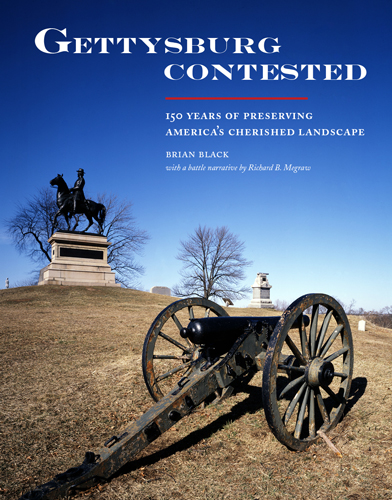
| |
 |
Gettysburg Contested: The first book to record how Gettysburg has been preserved and commemorated since 1863! Ever since the American Revolution, sites representing key events in American history were crucial to the young nation's efforts to formalize its story. And, following the Civil War, national history became a primary vehicle for patriotic and spiritual reconstruction, and sites such as historic battlefields served important roles in remembering the past during the nation's subsequent challenging periods, including the Great Depression and Vietnam War. Gettysburg Contested traces these patterns of commemoration back to the well-known field of battle of July 1–3, 1863, earning for it a new and lasting legacy as sacred ground that remains today, more than 150 years later. But the landscape history and record of preservation at Gettysburg is complicated, for Gettysburg has wrestled large issues, ranging from public vs. private development to the role of local vs. state vs. federal government, to the actual implementation of memorialization on the battlefield. While the story of the battle is ingrained in the fabric of American memory, Brian Black's account considerably broadens the scope. Never before has Gettysburg's story been told so completely, offering layer upon layer, story upon story, to great effect. Gettysburg thus becomes a springboard to understanding more fully the nation's need for sacred sites and symbols of America's past, including cherished landscapes such as Gettysburg. In Gettysburg Contested, America's treasured battlefield becomes the great laboratory for how Americans preserve and honor the past. Like America itself, the story continues to unfold right before our eyes. FROM THE INTRODUCTION "The efforts to maintain the memory of Gettysburg have focused predominantly on the landscape that hosted the battling Confederate and Union forces in the hot summer of 1863. The landscape has passed through many differing episodes in the culture of historic preservation, many of which involved neither the National Park Service nor the federal government. Although Gettysburg has often acted as a measuring stick from which lessons of historic preservation could be applied nationwide, the unique importance of the battlefield in American history and culture has also, at times, made it very much an exception to national trends in preservation. Thus, the story of commemoration, memorialization, and landscape change at Gettysburg since the battle of 1863 offers important lessons to our collective understanding not only of that pivotal event, but the larger idea that President Abraham Lincoln conveyed just four and a half months later in his famous Gettysburg address of November 19: how best to remember, how best to consecrate the past so that those who died here "did not die in vain—that this nation, under God, shall have a new birth of freedom—and that government of the people, by the people, for the people, shall not perish from the earth."
|
$34.95 U.S. (trade discount) No e-book has been authorized. Published in April 2019 Distributed by University of Virginia Press Published in association with the American Land Publishing Project About the Author and the Essayist Book Events:
|